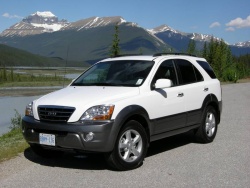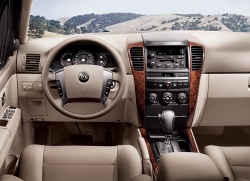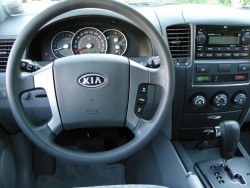 2008 Kia Sorento; photo by Paul Williams. Click image to enlarge |
|
Related articles on Autos
Manufacturer’s web site |
By Chris Chase
The Kia Sorento was a bit of an anomaly when it was introduced in 2003; not that a body-on-frame SUV is all that unique: it’s a proven, if antiquated, design – but it made the Sorento stand out as one of just a few SUVs at the small end of the mid-size segment not based on a car platform.
That original Sorento was powered by a 3.5-litre V6 similar to those found in the Hyundai XG350 and Kia Sedona minivan. Power, at 192 hp and 217 lb-ft of torque, was respectable, but trailed behind the similarly-sized Nissan Pathfinder, which offered 250 horses (240 with an automatic transmission). Kia wouldn’t address the power issue until 2007, when the Sorento began using a 3.8-litre V6 shared with a number of other Kia and Hyundai models; the new motor boasted 262 horsepower and 260 lb-ft of torque. For 2008, Kia added a Hyundai-sourced 3.3-litre V6 as a lower-priced alternative.
 2003 Kia Sorento; photo by Paul Williams. Click image to enlarge |
If the new engine made the Sorento more competitive power-wise, it also offered improved fuel consumption. With the old 3.5-litre, according to Natural Resources Canada, you can expect fuel consumption around 16 L/100 km in the city, and about 11 L/100 km on the highway. By contrast, the new 3.8-litre is rated at 14 L/100 km (city) and just under 10 L/100 km (highway); the 3.3-litre matches the 3.8’s city number, does a little better on the highway.
Sorentos were available in three trim levels for its first four years: LX, EX and EX Luxury. In 2006, the EX model was de-contented to correspond with a price cut, and lost a number of luxury niceties that were then limited to the top-line EX Luxury. In 2007, Kia trimmed down the model range to two versions, the base SX and uplevel LX. For 2008 and 2009, the 3.3-litre engine was offered in L, LX and LX Luxury trims, and the 3.8-litre in LX Luxury.
The 2007 model’s larger engine meant a larger towing capacity: early versions are rated to tow 3,500 pounds (about 1,600 kg), while 2007-and-newer ones with the 3.8-litre engine can haul 5,000 pounds (about 2,300 kg).
  2006 Kia Sorento (top); 2008 Kia Sorento, photo by Paul Williams. Click image to enlarge |
For the first two years on the market, the Sorento was available exclusively with a four-speed automatic transmission. In a field where automatics are the norm, a five-speed manual was a surprising addition in 2005, but was available only in the bottom-end LX model. A five-speed automatic replaced the four-speed automatic that year as well. Manual transmission examples will be hard to find, however
Sorentos sold up until 2005 got a shift-on-the-fly four-wheel drive system in lower end models, and the upscale EX got an electronic torque-on-demand system with a limited-slip differential. That automatic setup became standard in 2006. In 2008 and 2009, the 3.3-litre engine was paired with a part-time four-wheel drive system, and the 3.8-litre with a full-time, on-demand setup.
As with many vehicles that sell in relatively small numbers, finding trustworthy reliability information on the Sorento is difficult. There are two popular Sorento discussions in the forums at Edmunds.com (here and here, but the forum layout here makes it difficult to follow a single topic; finding useful information would mean sifting through hundreds of pages of posts.











